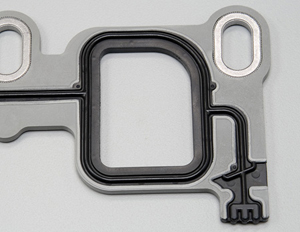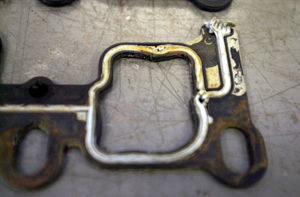 Back in the days when most engines had cast iron blocks, heads and manifolds, the intake manifold could be easily sealed with simple and relatively inexpensive die cut fiber faced metal gaskets (solid or perforated core). Sealer was usually required to ensure a leak-free installation.
Back in the days when most engines had cast iron blocks, heads and manifolds, the intake manifold could be easily sealed with simple and relatively inexpensive die cut fiber faced metal gaskets (solid or perforated core). Sealer was usually required to ensure a leak-free installation.
But in the late 1980s and early 1990s, fuel systems and manifolds began to change. Multiport fuel injection meant the intake manifold no longer had to flow an air/fuel mixture, only air. This gave engine designers more freedom to optimize airflow. Manifolds became more complex, with long curving runners and intricate plenums engineered to improve throttle response and low speed torque. Some were also fitted with tuning valves that could reroute air inside the manifold to change air velocity and flow according to engine speed and load. Plastic became a popular material for casting manifolds due to its low weight and cost.
During this same time period, cast iron cylinder heads were replaced with ones made of aluminum to save weight. This created a sealing challenge in areas where different materials with different thermal characteristics and different corrosion characteristics were bolted together. The solution some auto makers chose to use was a new type of intake manifold gasket that had raised synthetic rubber silicone beads around the intake ports and coolant passages. When the intake manifold bolts are tightened down, it deforms the raised sealing beads and presses the beads tightly against the surface of the head and manifold to seal the joint.
These new style intake gaskets also had a nylon-filled plastic carrier that formed the body of the gasket. The carrier itself (or steel grommets inserted into the carrier) prevented over-torquing by limiting crush when the intake manifold bolts were tightened down.

These “high tech” intake manifold gaskets were much more sophisticated (and expensive) than their predecessors, and seemed like the perfect solution for a difficult sealing job. But as we found out with the passage of time, some of these fancy intake manifold gaskets didn’t hold up very well.
After 60,000 to 70,000 miles, many of these carrier style intake manifold gaskets develop coolant leaks that can cause an engine to overheat or even fail if enough coolant gets into the crankcase. Apparently, the nylon-filled plastic used in the carrier is being attacked by the coolant, causing it to soften and deform. Eventually, this causes the raised sealing beads around the coolant ports to lose their seal and leak. The failure often occurs during cold weather as a result of thermal contraction when the metal head pulls away from the gasket. Problem Applications Engines that have had high intake gasket failure rates include 1990 to 2005 Buick, Chevrolet, Oldsmobile and Pontiac 3.1L, 3.4L, 3.8L and 4.3L V6 engines, and 1996 to 2002 Chevy 5.4L and 5.7L V8 engines. These applications alone represent a potential replacement market of more than 10 million vehicles.
In addition, similar problems have also been observed on some late model Ford engines such as the 3.8L, 3.9L, 4.0L and 4.2L V6 engines, and 4.6L and 5.4L V8s. Similar intake manifold gasket failures have also occurred on some 1990 to 2002 Chrysler 3.3L and 3.8L V6 engines.
GM has issued a number of technical service bulletins describing the problem and recommended repairs (which may require replacing the intake manifold bolts as well as the gaskets). Here are some of the bulletins:
• TSB 03-06-01-010B covers intake manifold leaks on 1999-2003 3.1L & 3.4L engines.
• TSB 03-06-01-016 covers intake manifold leaks on 2000-2003 3.8L engines.
• TSB 01-06-01-007A covers intake manifold leaks on 1995-98 3.8L engines.
What’s Causing The Leaks?
The coolant leaks on these engines are the result of a combination of factors: heat, thermal cycling, coolant neglect, corrosion and degradation of the OEM gasket.

Some have blamed the coolant leak problem on the type of plastic used in the OEM gaskets. They say the nylon-filled plastic material was not robust enough to maintain its strength and integrity for the life of the engine. As a result of vibration and thermal expansion/contraction, the plastic becomes brittle and cracks, exposing the gaskets silicone sealing beads. The coolant causes the silicone beads to swell, further weakening the carrier.
Others say the gasket failure problem was caused by the type of antifreeze used in the cooling system, blaming Dexcool for GM’s intake manifold gasket leaks. Dexcool has been the factory coolant in GM vehicles since 1996. Like the long life coolants that Ford, Chrysler and other auto makers use, it contains “organic acid technology” (OAT) corrosion inhibitors. The OAT corrosion inhibitors are not as alkaline as those used in traditional “green” formula antifreezes, but they are longer lived.
Dexcool (as well as most other OAT-based coolants) has a claimed service life of 5 years or 150,000 miles, which ever comes first (not last). But many motorists think this means forever, so they never check or change their coolant. Consequently, when the corrosion inhibitors in the coolant wear out, electrolytic corrosion can attack metal and even plastic and rubber surfaces in the cooling system.
If Dexcool was such a bad coolant, as some people have said it is, it would start to attack the intake gaskets as soon as it was poured into the cooling system. That’s not the case, nor does that occur with any other brand of long life coolant. The problem is not the brand or type of coolant in the cooling system. The problem is any type of corrosion inhibitor will eventually wear out. Once this happens, the coolant becomes acidic and allows corrosion to attack the metal surfaces around the coolant ports as well as the intake manifold gaskets.
On engines with aluminum cylinder heads, corrosion typically erodes the area around the coolant ports. If the plastic under the sealing bead on the intake manifold gasket is eaten away, the gasket can’t hold a seal and will leak. In this case, you can’t blame the leak on the gasket. Blame the vehicle owner for not maintaining their vehicle. On the other hand, if the OEM gaskets had been made from a more robust material or engineered with secondary sealing beads around the coolant ports, maybe they wouldn’t be failing at low mileage.
GM has redesigned the intake manifold service gaskets for some of their problem applications. They’ve changed the sealing beads from silicone rubber to a tougher material called fluoroelastomer (FKM) rubber, which is much more resistant to oils, solvents and chemical attack. The location of the sealing beads on some applications have also been revised somewhat. The original OEM gaskets as well as the revised service gaskets are usually black with orange sealing beads. Aftermarket Solutions Aftermarket gasket manufacturers have also come up with their own sealing solutions for these problem engines. In 2004, Fel-Pro introduced its new “PermaDryPlus” intake manifold gaskets for engines originally equipped with plastic carrier gaskets. The Fel-Pro intake manifold gaskets have an aluminized steel carrier rather than a plastic carrier, and use a proprietary black fluoroelastomer FKM rubber compound for the sealing beads. What’s more, instead of having just one sealing bead around the coolant passages, Fel-Pro uses three concentric sealing beads to provide redundancy. The beads have also been relocated to accommodate minor corrosion around the ports. The gaskets also have self-centering torque limiters to limit over compression of the gasket when it is installed.
Victor Reinz approach to sealing the troublesome GM and Ford engines is to use tougher materials for both the carrier and sealing beads on the intake manifold gaskets. The carriers are made of grey “non-hydrolysis” plastic material so they don’t absorb moisture and become soft like the older, nylon-filled materials. The coolant ports are surrounded with black HNBR (hydrogenated nitrile butadiene rubber). HNBR can withstand acidic coolants and is much more durable than silicone rubber. The HNBR material also forms the sealing beads on the Victor Reinz gaskets. On the Victor Reinz gaskets for Ford 4.0L and GM Gen III and IV V8 engines, green FKM rubber is used to seal the intake ports while HNBR is used for the coolant ports. These engines have exhibited manifold gasket failures linked to fuel attacking the beads sealing the intake ports. FKM rubber is extremely resistant to gasoline, while HNBR is far more resistant to acidic coolants, hence the best of both worlds in one gasket. The plastic carriers on various applications are also fitted with steel load limiters so the gasket cannot be over-tightened.
ROL says it is using intake gasket manifold materials that are similar to the OEM materials, with a nylon-filled plastic carrier and silicone rubber sealing beads. ROL says these materials work fine provided the coolant is maintained properly. Installation Precautions When rebuilding high mileage engines, pay close attention to the condition of the sealing surfaces around the coolant ports on the heads. If this area is eroded or pitted, the intake manifold gaskets may not seal properly when the engine is assembled.
In some cases, it may be possible to clean up the mating surface on a pitted head by lightly resurfacing the intake port side of the head. Pits can also be filled and sealed with high temperature epoxy fillers, then sanded or machined flat to restore a smooth, flat surface. If the erosion is severe, it might even be necessary to build up the damaged area by TIG welding the head, or replacing it altogether with a new or salvage casting.
According to one aftermarket gasket manufacturer, the recommended surface finish for the intake manifold and cylinder head mating surfaces should ideally be 30 to 60 microinches Ra (Roughness Average). Another gasket manufacturer said anything from 20 to 80 Ra should be good enough.
Unlike the super smooth surface finish that’s usually required for late-model MLS head gaskets (20 Ra or less), the surface finish for most intake manifold gaskets isn’t as critical. Even so, it must be smooth, flat and clean, with minimal pitting and waviness. If the intake manifold or intake ports on the head are milled at too high a feed rate, it can leave an undulating wavy finish with ridges and valleys that can be difficult to seal. This may result in coolant or vacuum leaks, as well as premature failure of the intake manifold gasket sealing beads.
Overall flatness on both mating surfaces should also be checked with a straightedge and feeler gauge. Flatness should be .003˝ or less on the mating face of the intake manifold and cylinder head intake ports on V6 engines, and .004˝ or less on a V8 or straight six.
Equally important, the intake manifold and head surfaces must be clean (no grease, oil or coolant film) and dry. RTV, other sealants or adhesives should not be used around the coolant or intake ports on carrier-style gaskets. The only place RTV silicone may be required is to seal the area where the ends of the intake manifold gaskets mate with the end strip seals on the block under the intake manifold or valley cover.
It’s also essential that the threads for the intake manifold bolts in the head be clean and undamaged, as this can affect clamping torque. New intake manifold bolts are recommended. But if you must reuse the old bolts, make sure the threads are clean and undamaged. Also, follow the recommended torque procedure when tightening down the intake manifold bolts and make sure it is the latest procedure as the original procedure and torque specs may have been revised.
For example, on the GM 3.1L engines, GM recommends using thread sealer on the intake manifold bolts. An oil leak may result if the vertical bolts are not tightened before the diagonal bolts on the lower intake manifold. Tighten the lower vertical intake manifold bolts to 115 in.lbs. (13 Nm), then tighten the lower diagonal intake manifold bolts to 115 in.lbs. (13 Nm).
Make sure you use an accurate torque wrench that has been calibrated within the last 6 to 12 months. If the intake manifold gasket does not make a tight seal around the coolant ports, it may leak coolant into the crankcase. If it fails to seal tightly around the intake ports, it may allow vacuum leaks that upset the air/fuel mixture and cause idle and driveabiliy issues.
Finally, make sure you have the correct replacement gasket for the application. On the GM 3.1 and 3.4L engines, there are two different gaskets: an early design with smaller intake ports and a later design with larger intake ports. The early and late heads on these engines are interchangeable, and it’s possible somebody may have swapped heads.













